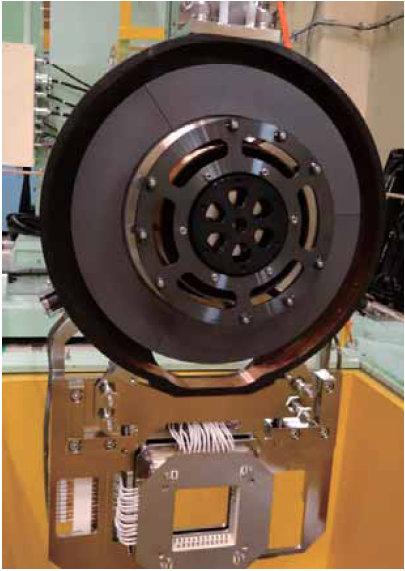2014 at MSL
◤ Inter-University Research Program
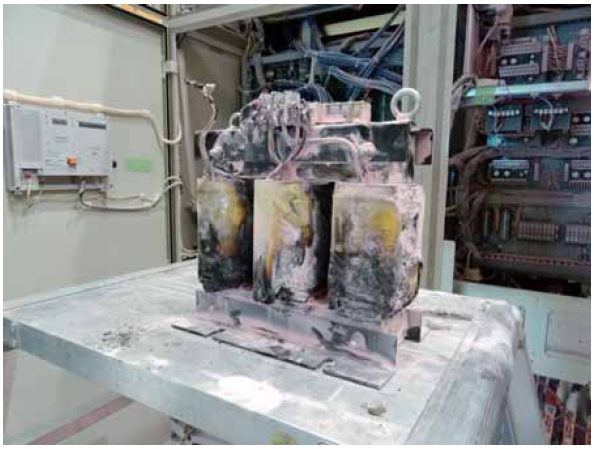
Fig1: The burned transformer disconnected from the power supply for the D-line septupole magnet. [enlarged view (418KB)]
J-PARC MUSE (Muon Science Establishment) returned to normal operation after proton beam delivery resumed in February 2014 following the Hadron Hall incident in the preceding year. Since then, it has hosted 27 user experiments out of the 51 approved proposals for the entire 2014A term and part of the 2014B term, toward the end of the year on the muon D-line under the Inter- University Research Program, operating for 74 days at a proton beam power of 300 kW. In addition, the instrument group used 30 days of the year for commissioning. However, the scheduled restart after a short break, in the beginning of 2015, was deferred by a fire incident at the MUSE on January 16, 2015 that left the entire Material and Life Science Facility (MLF) in limbo for a month. This led to the cancellation of 23 muon experiments, including part of a Project Use experiment, and rendered 67 days unavailable for user runs in the 2014B term.
The fire incident was caused by faulty design of a renovated power supply for one of the D-line magnets (septupole) that led to overcurrent in a transformer that was newly added to the original system. Fortunately, the fire was immediately extinguished by the MUSE staff, and there were no casualties or any radiation hazards at the incident site. Although the hardware damage was limited to the burned transformer (see Fig. 1), it is likely to take a few months for the restoration of D-line.
◤ Facility Development
1. D-line: New instruments
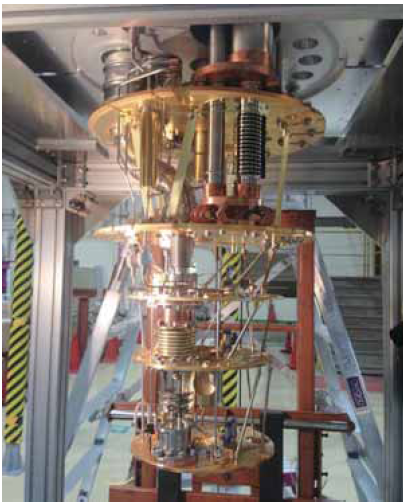
Fig2: The insertion unit of a new 3He- 4He refrigerator for μSR experiment in the D1 area. [enlarged view (422KB)]

Fig3: Top view of the new instrument installed at the beam exit of D2 area. [enlarged view (426KB)]
A new 3He-4He dilution refrigerator (DR) for μSR experiments was successfully commissioned, and put in service at the D1 area since 2014B (see Fig. 2). It is cooled down to the liquid helium temperature using a closed-cycle refrigeration system using the Pulse-Tube Refrigeration Scheme, so that the DR can be operated without a liquid coolant. The sample exchange can be performed during the operation using a top-loading device, which takes less than 12 h. A group from Sophia University was the first to conduct an experiment using the brand-new DR to study the magnetism of high-Tc cuprates.
In the D2 area, a new instrument dedicated to muonic X-ray non-destructive element analysis has been put on-line (Fig. 3). It is furnished with a large vacuum chamber made of aluminum, in order to reduce the background noise from high atomic number materials and several germanium X-ray detectors covering a relatively large solid angle. In addition, the optimization of beam transport for low-momentum negative muons is in progress, so that the technique can be applied to thin film samples with a thickness of a few micrometers.
2. U-line: Ultra Slow Muon beamline in struggle
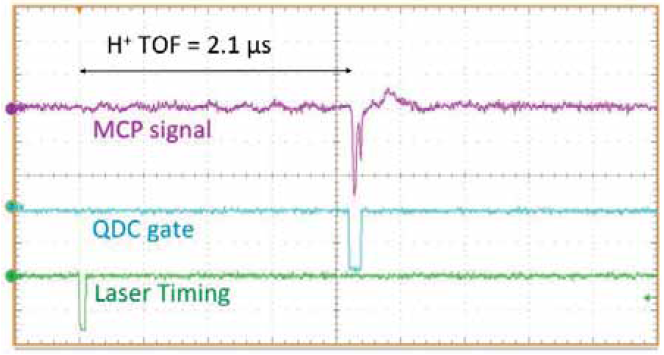
Fig4: The experimental area of the Ultra Slow Muon beamline, where the silver cage in the U1A area covers the μSR spectrometer high-voltage stage. [enlarged view (262KB)]
The plan of the first Ultra Slow Muon beam, envisaged in the previous year, was disrupted by a severe trouble in the U-line. In late 2013, it was discovered that the superconducting curved solenoid magnet was unable to cool down to the temperature required for normal operations. The cause was later identifi ed to be the breakdown of a thin foil at the front-end of the solenoid coil used for shielding against thermal radiation. Because of the diffi culty in accessing the broken part during beam operation, the repair work was postponed to the summer shutdown of FY2014. The foil was successfully replaced, and the solenoid magnet was confirmed to be ready for resumption of beam in November 2014. Thus, it took an entire year to put the U-line back in service.
Meanwhile, development of a high-power laser system for the resonant ionization of thermal muonium made steady progress. Although the main amplifi er was still to be completed, the RIKEN-KEK team was successful in observing that the hydrogen atoms floating in the muonium generation chamber were resonantly ionized by the Lyman-α laser and transported to a detector placed at the end of Ultra Slow Muon beamline (Fig. 4), demonstrating that the whole set-up was nearly ready for the delivery of the first beam.
3. S-line: Almost ready for beam delivery

Fig5: A picture taken during the installation of a cooling water system to S-line magnets in the Experimental Hall No.1. [enlarged view (397KB)]
In the Experimental Hall No.1, construction work for a part of the S-line and the adjacent S1 area are in the final stage. Following the completion of the gallery for magnet power supplies, user cabin, and radiation shields in FY2013, beamline magnets and associated infrastructure (cooling water, electric power cables, controlling system, and so on, see Fig. 5) were installed. In November 2014, all the components were integrated into the S-line and subjected to inspection for radiation safety by a third party organization, and were endorsed to be ready for beam operation. The first beam up for commissioning will be due in early FY2015.
4. Muon Production Target: Rotating target is up and running
After years of research and development, the rotating target was finally rolled into the primary proton beamline and used for muon production at a beam power of 300 kW since November 2014 (Fig. 6). Prior to this, a series of commissioning works, including recovery and storage of the fi xed target by remote handling were performed. The fixed target, which had been in operation since 2008, was finally evacuated from the proton beamline and replaced with a new rotating target during the summer shutdown. The new target was exposed to a proton beam with a power of 470 kW for 1.5 h at the beginning of the beam operation, as part of commissioning for the scheduled ramp-up of beam power. The tolerance of the target was examined.
◤ Scientific Activities
1. Discovery of the secondary antiferromagnetic phase in iron-based superconductor
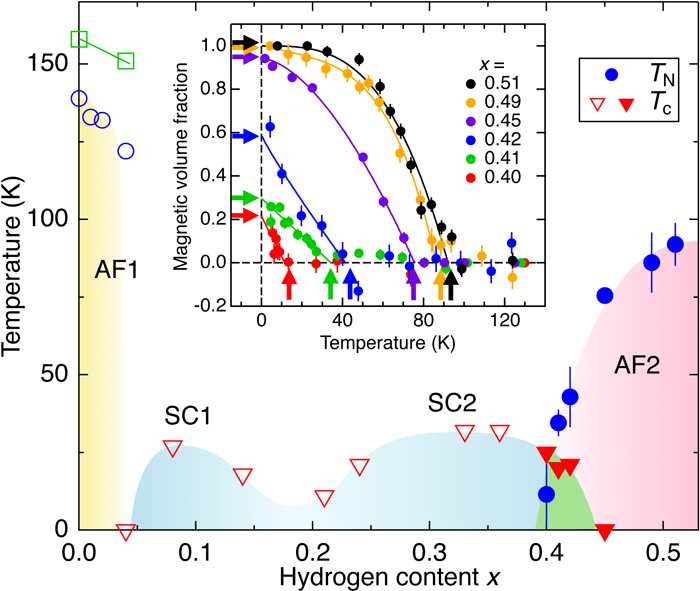
Fig7:A new magnetic phase (AF2) whose Neel temperature (TN) was mapped out by μSR measurements. (Inset: Magnetic volume fraction vs. temperature determined by μSR.) [enlarged view (266KB)]
A new antiferromagnetic phase has been identified in a prototype iron-based superconductor, LaFeAsO1-xHx (LFAO-H), over a range of unprecedentedly high carrier concentration (x > 0.4) [1]. It was previously reported that the range of carrier doping was extended to a much higher concentration (x > 0.2) by substitution of oxygen by hydrogen in place of fluorine. Here, the secondary maximum of the superconducting transition temperature (Tc) is observed at a hydrogen content of x ~ 0.35 (Iimura et al., 2012). A preliminary NMR study suggested an emergence of a certain kind of magnetism in the overdoped region. Based on this, a team of experts on muon, neutron, and synchrotoron radiation (SR)-x-ray (working together for the "Element Strategy Initiative" project being conducted at the Condensed Matter Research Center, CMRC) has made a concerted effort with a group from Tokyo Inst. Tech. to shed light on the electronic properties of LFAO-H over the region of large H content. Here, the muon spin rotation technique served to map out the Nėel temperature (TN) vs. x in a timely fashion (Fig. 7). Subsequent measurements by neutron and SR-x-ray inferred that the magnetic structure is different from that observed in the low x region, and that the magnetic transition accompanies structural change to a non-centrosymmetric structure (Aem2) at x = 0.5. These observations suggest that the new phase might be regarded as another "parent" for the secondary superconducting phase.
2. Depth-resolved non-destructive element analysis for light elements
The element-specific x-rays emitted upon the atomic capture of negative muons (muonic x-rays) have a great advantage over conventional techniques. Owing to their high energy, they are much more permeable than the normal fluorescent x-rays. This feature, combined with a variable muon beam energy for controlling implantation depth, allows us to use muonic x-rays for bulk-sensitive element analysis for lighter elements such as carbon without invasion, as negative muon irradiation does not cause the specimen to be radioactive.
A research team of K. Terada and his co-workers conducted an experiment to test the feasibility of applying the muonic x-ray technique for analysis of meteorites, on which they hope to identify a small amount of carbon as primordial element for life. They were successful in demonstrating a depth-profi le of light elements (B, C, N, and O) from a mockup specime (consisting of several millimeter thick layered materials) and conducting a nondestructive bulk analysis of meteorites containing organic materials [2]. They plan to use this technology to identify the content and distribution of organic components in future asteroidal return samples.
3. Muonium in Stishovite mimicking atomic hydrogenin Earth's lower mantle
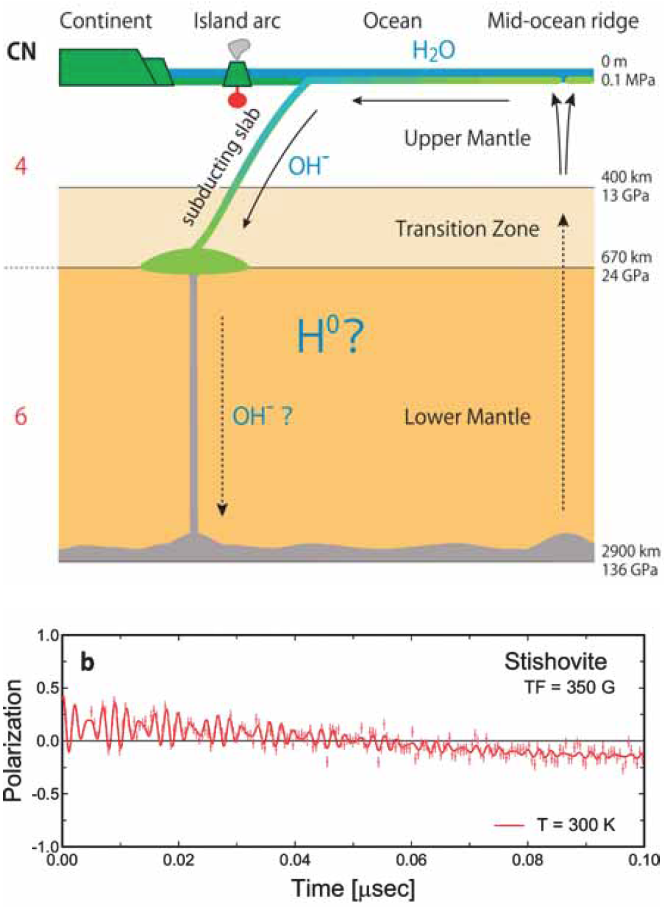
Fig8:(Top) A schematic of the Earth's Cross-section showing a possible path for hydrogen intake. (Bottom) Muonium precession signal observed in stishovite. [enlarged view (356KB)]
Hydrogen in Earth's deep interior has been thought to exist as a hydroxyl group in high-pressure minerals. The water in anhydrous silicates is considered to be related to lattice defects and incorporated into the system, for example, by simultaneous substitutions such as Mg2+ → H+ and O2− → OH−. It has been reported that the mantletransition zone can accommodate a signifi cant amount of H2O components, up to several times the total mass of oceans. In addition, though not a consensus, it is understood that the lower mantle could also accommodate a non-negligible amount of H2O components. A group led by N. Funamori (U. Tokyo) has performed a μSR study on SiO2 stishovite, which is an archetypal high-pressure mineral in the Earth's lower mantle, to show that implanted muon forms muonium that mimics the state of neutral hydrogen in matter [3]. The hyperfine-coupling parameter and the relaxation rate of spin polarization of muonium in stishovite were measured to be very large, suggesting that muonium is squeezed in small and anisotropic interstitial voids without binding to silicon or oxygen. These results imply that in the deep mantle, hydrogen may also exist in the form of neutral atomic hydrogen.
◤ MAC

Fig9: A group photo of MAC members surrounded by the J-PARC Muon Section staff. [enlarged view (463KB)]
The Muon Advisory Committee (MAC) was convened from February 11 − 12, 2015, at the Tokai campus under the charge of J-PARC Center director, to review the operation/maintenance of the MUSE facility and related technical developments in the past year (Fig. 9). The committee was formed to advise on achieving the following objectives: 1) A clear vision of the time-line and the experimental layout of the facility, considering that it has been designed to be the most powerful muon facility, 2) careful management skills to ensure stable operation of J-PARC as a multi‐purpose user facility, and 3) due precautions for safety in user operations. The final report will be delivered to both KEK-IMSS and J-PARC Center directorates sometime in May 2015.
References
[1] M. Hiraishi et al., Nature Phys. 10, 303 (2014).
[2] K. Terada et al., Scientifi c Reports 4, 5072 (2014).
[3] N. Funamori et al., Scientifi c Reports 5, 8437 (2015).
